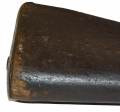site search
online catalog
CONFEDERATE ADAMS ALTERED CITY OF RICHMOND MARKED VIRGINIA MILITIA MUSKET: POSSIBLY ALSO 2nd NC BATTALION, WISE LEGION

$3,500.00 SOLD
Quantity Available: None
Item Code: 1000-248
This is a scarce Confederate percussion conversion by Adams of an equally scarce 1780s Virginia imported French musket, one of 3,390 purchased by the state to arm its militia in 1786. The purchase was made under a 1785 authorization and negotiated at the Tulle Arsenal, responsible for naval and colonial arms, with the first shipment arriving at the Virginia’s Point of Fork Arsenal in December 1786 and the second in July 1787. This one is marked on the barrel, “[…] REG. CITY. OF. RICHMOND.” indicating its issue to a regiment in that city, the marking following state practice of marking the barrel with regimental numerals and location starting in 1801. The number is not legible, but certainly read “19. VA.” The 19th Regiment was located in the City of Richmond (with the 41st coming from the county) and Moller records one musket so marked.
The muskets in these shipments were the French M1777 Colonial and Marine musket, one of three types made at the arsenal, and was intended for issue to troops raised in the French colonies. The pattern is .69 caliber and uses a brass buttplate, L-shaped sideplate, triggerguard bow, pan, lower band and upper double-strapped band, but with an iron middle band. The left buttstock has a recessed cheekrest and the barrel was fitted with a bayonet stud on the bottom of the muzzle. A December 1859 inventory of the state arsenal in Richmond recorded 400 “brass mounted” flint muskets, likely these, that were in “good order” and suitable for conversion to percussion. The bolster used in the process is characteristic of Thomas J. Adams, one of nine contractors altering pistols, rifles, and muskets for the state and for the CS Ordnance Department from 1861 through the winter of 1862.
The musket rates good for condition. The barrel is a crusty brown with pitting overall. The lockplate is smoother and a mix of gray and brown with what looks like an old brazed repair near the forward screw. The lockplate markings are rubbed, but show part of “Mfr” and the name “Moulins” on the lockplate. The brass has uniform, dark, untouched patina. The barrel was taken down to 38 inches and the stock proportionally shortened, whether for wartime use or later civilian use is unclear, but there is no sign of a bayonet stud. The iron middle band is missing, with swivel is missing, but the lower sling swivel is still present on the triggerguard. The brass bands are numbered “99,” certainly mating numbers for reassembly. The wood has numerous dings, pressure dents, some abrasions and a few surface chips, but is solid and we see only two hairlines extending back from the breechplug tang and no large cracks or chips. The initials “JB” are twice carved in the wood, likely an owner’s initials. The left side flat shows a Roman numeral “XIX,” which is probably Adams’s mating number, though we have not disassembled the musket to check the inside of the lockplate and other locations he usually marked them. He seems to have numbered the muskets within the particular crate he was working on, with the numbers only running up to twenty (XX.) The buttstock shows a crowned-V stamp, certainly a French inspection mark: it is known the first shipment was inspected at Bourdeaux before shipment. Mechanics work but are soft; barrel is dirty.
Murphy and Madaus suggest that many of these muskets ended up with the 2nd North Carolina and other elements of the Wise Legion, to be surrendered at Roanoke in February 1862. Three hundred “Virginia flint-lock muskets” and bayonets were transferred from Virginia stores to Col. Green of the 2nd NC Battalion by Gov. Letcher of Virginia in September 1861, and Adams was paid for altering them from flint to percussion, along with a few stray others, in three groups in October and November. One of these, also a City of Richmond marked example, was captured by the Hawkins Zouaves at Roanoke and while we cannot say this one was there also, there is a good chance of it and it certainly shows they were taken into the field by Confederate troops. [sr] [ph:L]
DISCLAIMER: All firearms are sold as collector's items only - we do not accept responsibility as to the shooting safety or reliability of any antique firearm. All firearms are described as accurately as possible, given the restraints of a catalog listing length. We want satisfied customers & often "under" describe the weapons. Any city or state regulations regarding owning antique firearms are the responsibility of the purchaser. All firearms are "mechanically perfect" unless noted, but again, are NOT warranted as safe to fire.
~~~~~~~~~~~~~~~~~~~~~~~~~~~~~~~~~~~
THIS ITEM, AS WITH ALL OTHER ITEMS AVAILABLE ON OUR WEB SITE,
MAY BE PURCHASED THROUGH OUR LAYAWAY PROGRAM.
CLICK HERE FOR OUR POLICIES AND TERMS.
THANK YOU!
Inquire About CONFEDERATE ADAMS ALTERED CITY OF RICHMOND MARKED VIRGINIA MILITIA MUSKET: POSSIBLY ALSO 2nd NC BATTALION, WISE LEGION
For inquiries, please email us at [email protected]
Most Popular
Historical Firearms Stolen From The National Civil War Museum In Harrisburg, Pa »
Theft From Gravesite Of Gen. John Reynolds »
Cavalry Carbine Sling Swivel »
Fine Condition Brass Infantry Bugle Insignia »
featured item
CONFEDERATE GENERAL LUNSFORD LINDSAY LOMAX AS A WEST POINT CADET IN DAGUERREOTYPE BY ANSON CA. 1854/55, EX-BILL TURNER COLLECTION
Formerly in the collection of Virginia collector and dealer Bill Turner this ninth plate cased daguerreotype by Rufus Anson of New York City is extremely clear, nicely cased, has a mat showing the photographer’s name and address, and shows later… (1138-1905). Learn More »



























